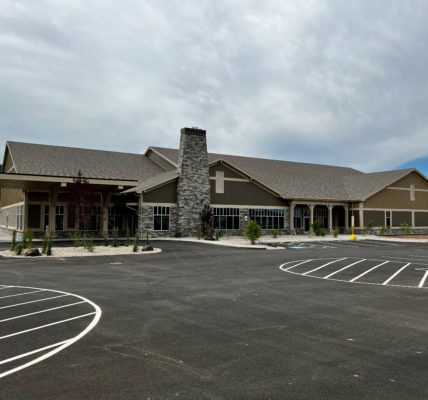By Mike Koshmrl – Jackson Hole News & Guide Via Wyoming News Exchange. Used with permission.
JACKSON — Aloft in a helicopter surveying the Tetons the other week, Aly Courtemanch again spotted mountain goats in new nooks of the range.
The Wyoming Game and Fish Department biologist also saw something concerning her and other wildlife managers in the region: native bighorn sheep mingling with their exotic mountain-dwelling relatives.
“Again this winter we saw goats expanding into some bighorn wintering areas,” Courtemanch said. “And we actually did see a bighorn sheep ram very close to a group of mountain goats in Upper Cascade Canyon. They might be sharing the same little patch of winter habitat.”
She estimated the distance from sheep to goats at 30 yards.
That proximity is potentially perilous for Teton’s bighorn sheep herd, which has never been exposed to a number of deadly pathogens that the goats, migrants from the Snake River Range, are known to harbor. Species-to-species transmission is possible at any time, and could result in an outbreak of deadly pneumonia that could diminish the bifurcated bighorn herd, which numbers just 100 head. Disease could wipe out the entire bighorn bunch due to its small size.
“The very short-term risk is the disease issue,” Wyoming Wild Sheep Foundation Executive Director Steve Kilpatrick said. “[Removing them] has to be quick. We have five known lethal pathogens, and we know that goats sampled south of here in the Palisades have all five. We know, from a small sample size, that we have two of the pathogens already here [in the park]. And we know we have a sheep herd that is naive to diseases.”
Long-term, he said, competition for habitat is another pressure on the sheep, and an influence that might explain why sheep numbers have slumped while the goat population has taken off in the last decade.
Biologists don’t have to look far to see examples of the devastating effects of pneumonia outbreaks in bighorn herds, which stem from pathogens that were originally passed along from domestic sheep. The Jackson Herd’s sheep, some of which winter at Miller Butte, and the Dubois-area Whiskey Mountain herd both harbor pathogens and both suffer from periodic pneumonia outbreaks, the worst of which claim hundreds of animals and take many years for herds to rebound.
Courtemanch and Kilpatrick both spoke at a meeting coordinated by Grand Teton National Park to inform the public of a National Park Service plan to kill and relocate the Teton’s 100-plus mountain goats.
While critics have sounded off online, those who came out to the meeting were there to support the park’s plan, though there was at least one exception. A Driggs, Idaho, man called the proposal a “damned joke.” He declined to give his name or consent to an interview.
La Barge resident and Wyoming Game and Fish Commissioner Mike Schmid made the two-hour drive to Jackson to support ridding the Tetons of its mountain goats, though he wanted the Park Service to consider letting the public hunt the animals instead of leaving the task to contracted aerial gunmen and professional hunters.
“I would hope the agencies can come together to come to some kind of a solution,” Schmid said, “because the goals are the same.”
Park Service policies prohibit hunting with exceptions, such as Teton Park’s elk hunt, only possible due to legislation approved by Congress.
The Tetons’ goat and sheep populations have both been trending in worrisome, undesirable directions, though good news emerged from this winter’s survey.
In 2013, when Teton Park first “scoped” its mountain goat plan, the population of the nonnative invading species was just 10 to 15 animals, park biologists told the News&Guide at the time.
During Courtemanch’s early December flight, she counted 88 — up from 66 a year ago — and estimated the population at “over 100” to account for those she missed. Those goats were found primarily in Cascade and Snowshoe canyons, though they’ve also fanned out to places like Olive Oyl Peak, and Moose Creek and Teton Canyon on the Tetons’ west slope.
The number of sheep counted the same flight was 81, more than have been tallied for a few years.
“It’s very encouraging,” Courtemanch said. “It’s still a very small population, but not as small as we thought it was a few years ago.”
Game and Fish supports Teton park’s goal of eliminating the goats, Courtemanch said, though there’s an internal discussion about what removal methods the state will back. To assist with the planned eradication, Wyoming wildlife managers are holding special draw-hunt for goats outside the park on Caribou-Targhee National Forest land beginning next fall. The licenses will be “Type A,” and they will not be once-in-a-lifetime like other mountain goat hunting opportunities in Wyoming.
It’s the native sheep herd’s fragility that the public seemed to home in on in rationalizing why it’s necessary to kill or move 100 or so mountain goats. The goats were first moved to the region by Idaho in the late 1960s and early ’70s, and drifted up from the Snake River Range herd that now straddles the state line.
“It’s a real hard one,” botanist Frances Clark said from the meeting. “The biologists — no one — wants to kill these mountain goats, however, one has to look to the longer-term health of the region and for the other wildlife. It’s a matter of head over heart — that’s what this is about.”
Kilpatrick, the Sheep Foundation director, likened killing the goats to save the sheep to amputating a leg to save someone’s life. Although a lifelong hunter, shooting a goat from a helicopter with a shotgun and leaving the meat to waste — part of the plan on the table — is a task he “couldn’t do, personally.” Still, he encouraged swift action.
“We simply have a very imperiled sheep herd that’s living on the edge in two ways,” Kilpatrick said. “One literally and one extinction-wise.”
Game and Fish Commissioner Schmid also stressed urgency.
“In general, I’m a little angered with this whole situation, simply because I don’t think they should even be here,” Schmid said. “If we would have done this five years ago, we wouldn’t have any mountain goats in the Tetons — or so few that it wouldn’t matter.”
Grand Teton National Park’s wildlife chief, Dave Gustine, said it was an understandable frustration. Declines in the sheep population and the upswing in goat numbers came about as the park’s planning process was coming to fruition.
Due to the disease threat, Gustine also worried for the future of the Tetons’ native sheep.
“We have detected a couple of the nasties — the pathogens — in the goats here that are related to respiratory pneumonia elsewhere,” Gustine said. “We’re definitely concerned about increased mortality, for sure.”





